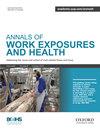228a - How can biomonitoring support occupational hygiene in a further reduction of exposure to hexavalent chromium? – Results from the HBM4EU chromate study
IF 1.8
4区 医学
Q3 PUBLIC, ENVIRONMENTAL & OCCUPATIONAL HEALTH
引用次数: 0
Abstract
Occupational exposure to hexavalent chromium (Cr6) deserves attention because of the evidence for an associated health risk, including cancer. As part of HBM4EU a study was conducted with the main aim to find out what biomonitoring can add to further improve work practices to reduce exposure to Cr6. In 2019, a cross-sectional study was carried out in 399 chrome workers and 203 controls in nine European countries. Total chromium (TCr) blood and urine was measured and TCr in erythrocytes was used as a measure of intracellular Cr6. Cr3 and Cr6 were analysed in inhalable and respirable dust collected from the breathing zone and for the assessment of dermal exposure hand wipes were collected. The biomonitoring results showed that production workers were higher exposed than controls. The highest exposures were found in chrome plating. Urinary TCr was associated with inhalation Cr6 exposure in a group of 57 plating workers (Spearman’s correlation coefficient of 0.783). An air concentration of 1 µg Cr6/m3 in the breathing zone corresponds to approx. 2 µg TCr/g creatinine in urine. Mechanisation of chrome baths was associated with lower TCr levels in urine compared to manual operation. An association was observed between TCr contamination on the hands and urinary TCr. Storing (used) work cloths in lockers was associated with higher urine TCr. In conclusion, biomonitoring results indicate that Cr6 can also be absorbed via other and indirect routes than (only) inhalation. There may be opportunities for occupational hygiene interventions leading to a further reduction of exposure to Cr6. Presented on behalf of the HBM4EU occupational study project team.228a - 生物监测如何支持职业卫生进一步减少六价铬?- HBM4EU 铬酸盐研究的结果
六价铬(Cr6)的职业暴露值得关注,因为有证据表明六价铬(Cr6)具有相关的健康风险,包括癌症。作为 HBM4EU 的一部分,开展了一项研究,其主要目的是了解生物监测能为进一步改进工作实践减少六价铬暴露带来哪些帮助。2019 年,在九个欧洲国家对 399 名铬工人和 203 名对照者进行了横断面研究。测量了血液和尿液中的总铬 (TCr),并将红细胞中的 TCr 用作细胞内 Cr6 的测量值。对从呼吸区收集的可吸入和可吸入粉尘中的 Cr3 和 Cr6 进行了分析,并收集了擦手纸以评估皮肤接触情况。生物监测结果显示,生产工人的接触量高于对照组。镀铬工人的暴露量最高。在一组 57 名电镀工人中,尿 TCr 与吸入 Cr6 暴露相关(斯皮尔曼相关系数为 0.783)。呼吸区 1 µg Cr6/m3 的空气浓度相当于尿液中约 2 µg TCr/g 肌酐。与手工操作相比,铬浴机械化与尿液中 TCr 含量较低有关。手部 TCr 污染与尿液 TCr 之间存在关联。将(用过的)工作服存放在储物柜中与尿液 TCr 较高有关。总之,生物监测结果表明,除(仅)吸入外,六价铬还可通过其他间接途径被吸收。可能有机会采取职业卫生干预措施,从而进一步减少六价铬的接触。代表 HBM4EU 职业研究项目组提交。
本文章由计算机程序翻译,如有差异,请以英文原文为准。
求助全文
约1分钟内获得全文
求助全文
来源期刊

Annals Of Work Exposures and Health
Medicine-Public Health, Environmental and Occupational Health
CiteScore
4.60
自引率
19.20%
发文量
79
期刊介绍:
About the Journal
Annals of Work Exposures and Health is dedicated to presenting advances in exposure science supporting the recognition, quantification, and control of exposures at work, and epidemiological studies on their effects on human health and well-being. A key question we apply to submission is, "Is this paper going to help readers better understand, quantify, and control conditions at work that adversely or positively affect health and well-being?"
We are interested in high quality scientific research addressing:
the quantification of work exposures, including chemical, biological, physical, biomechanical, and psychosocial, and the elements of work organization giving rise to such exposures;
the relationship between these exposures and the acute and chronic health consequences for those exposed and their families and communities;
populations at special risk of work-related exposures including women, under-represented minorities, immigrants, and other vulnerable groups such as temporary, contingent and informal sector workers;
the effectiveness of interventions addressing exposure and risk including production technologies, work process engineering, and personal protective systems;
policies and management approaches to reduce risk and improve health and well-being among workers, their families or communities;
methodologies and mechanisms that underlie the quantification and/or control of exposure and risk.
There is heavy pressure on space in the journal, and the above interests mean that we do not usually publish papers that simply report local conditions without generalizable results. We are also unlikely to publish reports on human health and well-being without information on the work exposure characteristics giving rise to the effects. We particularly welcome contributions from scientists based in, or addressing conditions in, developing economies that fall within the above scope.
 求助内容:
求助内容: 应助结果提醒方式:
应助结果提醒方式:


